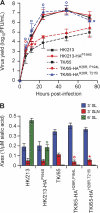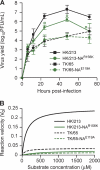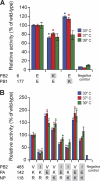Decreased neuraminidase activity is important for the adaptation of H5N1 influenza virus to human airway epithelium
- PMID: 22379077
- PMCID: PMC3347354
- DOI: 10.1128/JVI.06774-11
Decreased neuraminidase activity is important for the adaptation of H5N1 influenza virus to human airway epithelium
Abstract
Highly pathogenic avian H5N1 influenza viruses remain a pandemic threat. Antiviral drugs such as neuraminidase (NA) inhibitors will be crucial for disease control in the event of a pandemic. Should drug-resistant H5N1 viruses develop, all defense strategies will be compromised. To determine the likelihood and mechanisms of emergence of NA inhibitor-resistant H5N1 variants in humans, we serially passaged two H5N1 viruses, A/Hong Kong/213/03 and A/Turkey/65-1242/06, in normal human bronchial epithelial (NHBE) cells in the presence of oseltamivir, zanamivir, or peramivir. To monitor the emergence of changes associated with the adaptation of H5N1 viruses to humans, we passaged the strains in the absence of drugs. Under pressure of each NA inhibitor, A/Turkey/65-1242/06 developed mutations in the hemagglutinin (HA) (H28R and P194L/T215I) and NA (E119A) proteins that reduced virus binding to α2,3-sialyl receptor and NA activity. Oseltamivir pressure selected a variant of A/Hong Kong/213/03 virus with HA P194S mutation that decreased viral binding to α2,6 receptor. Under peramivir pressure, A/Hong Kong/213/03 virus developed a novel NA mutation, R156K, that reduced binding to all three drugs, caused about 90% loss of NA activity, and compromised replication in NHBE cells. Both strains were eliminated in NHBE cells when they were cultivated in the absence of drugs. Here, we show for the first time that decreased NA activity mediated through NA inhibitors is essential for the adaptation of pandemic H5N1 influenza virus to humans. This ability of decreased NA activity to promote H5N1 infection underlines the necessity to optimize management strategies for a plausible H5N1 pandemic.
Figures





Similar articles
-
Human-like receptor specificity does not affect the neuraminidase-inhibitor susceptibility of H5N1 influenza viruses.PLoS Pathog. 2008 Apr 11;4(4):e1000043. doi: 10.1371/journal.ppat.1000043. PLoS Pathog. 2008. PMID: 18404209 Free PMC article.
-
Competitive fitness of influenza B viruses with neuraminidase inhibitor-resistant substitutions in a coinfection model of the human airway epithelium.J Virol. 2015 Apr;89(8):4575-87. doi: 10.1128/JVI.02473-14. Epub 2015 Feb 11. J Virol. 2015. PMID: 25673705 Free PMC article.
-
Profiling and characterization of influenza virus N1 strains potentially resistant to multiple neuraminidase inhibitors.J Virol. 2015 Jan;89(1):287-99. doi: 10.1128/JVI.02485-14. Epub 2014 Oct 15. J Virol. 2015. PMID: 25320319 Free PMC article.
-
Influenza neuraminidase inhibitors: antiviral action and mechanisms of resistance.Influenza Other Respir Viruses. 2013 Jan;7 Suppl 1(Suppl 1):25-36. doi: 10.1111/irv.12047. Influenza Other Respir Viruses. 2013. PMID: 23279894 Free PMC article. Review.
-
Recent advances in neuraminidase inhibitor development as anti-influenza drugs.ChemMedChem. 2012 Sep;7(9):1527-36. doi: 10.1002/cmdc.201200155. Epub 2012 Jul 16. ChemMedChem. 2012. PMID: 22807317 Review.
Cited by
-
Influenza A Virus Agnostic Receptor Tropism Revealed Using a Novel Biological System with Terminal Sialic Acid Knockout Cells.J Virol. 2022 Aug 10;96(15):e0041622. doi: 10.1128/jvi.00416-22. Epub 2022 Jul 18. J Virol. 2022. PMID: 35862707 Free PMC article.
-
Neuraminidase (NA) 370-Loop Mutations of the 2009 Pandemic H1N1 Viruses Affect NA Enzyme Activity, Hemagglutination Titer, Mouse Virulence, and Inactivated-Virus Immunogenicity.Viruses. 2022 Jun 14;14(6):1304. doi: 10.3390/v14061304. Viruses. 2022. PMID: 35746775 Free PMC article.
-
Influenza B-cells protective epitope characterization: a passkey for the rational design of new broad-range anti-influenza vaccines.Viruses. 2012 Nov 14;4(11):3090-108. doi: 10.3390/v4113090. Viruses. 2012. PMID: 23202517 Free PMC article. Review.
-
Insight into the first multi-epitope-based peptide subunit vaccine against avian influenza A virus (H5N6): An immunoinformatics approach.Infect Genet Evol. 2022 Oct;104:105355. doi: 10.1016/j.meegid.2022.105355. Epub 2022 Aug 22. Infect Genet Evol. 2022. PMID: 36007760 Free PMC article.
-
Fitness costs for Influenza B viruses carrying neuraminidase inhibitor-resistant substitutions: underscoring the importance of E119A and H274Y.Antimicrob Agents Chemother. 2014 May;58(5):2718-30. doi: 10.1128/AAC.02628-13. Epub 2014 Feb 24. Antimicrob Agents Chemother. 2014. PMID: 24566185 Free PMC article.
References
-
- Alexander WJ, et al. 2007. Nasal and pharyngeal concentrations of peramivir following intramuscular and intravenous administration in health volunteers, poster A-1410. Abstr. 47th Intersci. Conf. Antimicrob. Agents Chemother American Society for Microbiology, Washington, DC
-
- Beigel JH, et al. 2005. Avian influenza A (H5N1) infection in humans. N. Engl. J. Med. 353:1374–1385 - PubMed
-
- Bovin NV, et al. 1993. Synthesis of polymeric neoglycoconjugates based on N-substituted polyacrylamides. Glycoconj. J. 10:142–151 - PubMed
-
- Cheung CL, et al. 2006. Distribution of amantadine-resistant H5N1 avian influenza variants in Asia. J. Infect. Dis. 193:1626–1629 - PubMed
Publication types
MeSH terms
Substances
Grants and funding
LinkOut - more resources
Full Text Sources
Other Literature Sources
Medical

